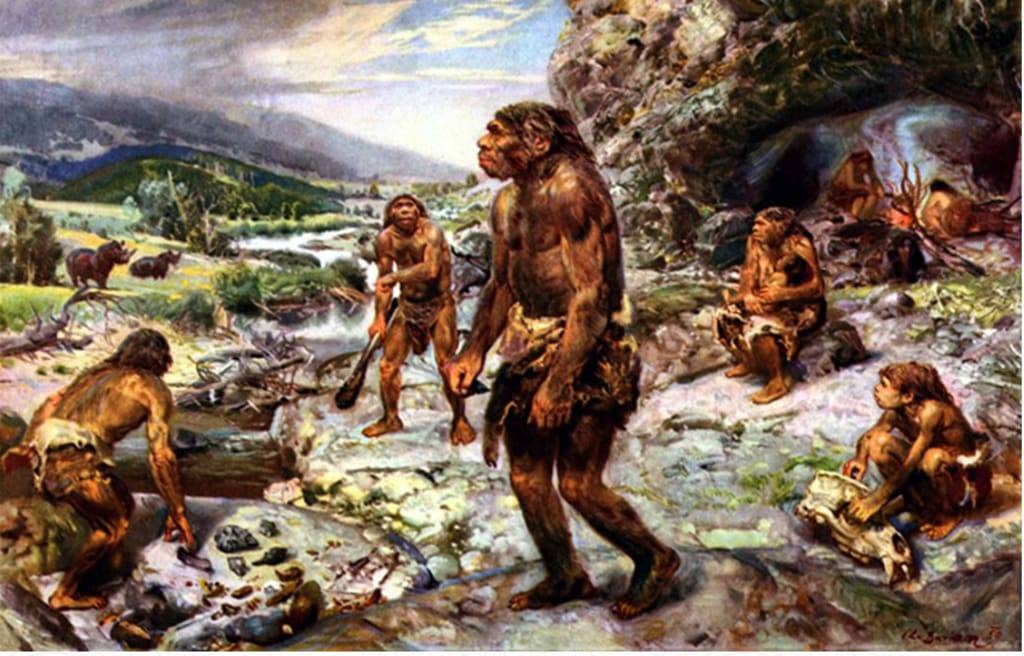When most people think about our distant ancestors, many envision a group of ape-like creatures huddled in a cave trying to break bones open with a rock. While this isn't entirely wrong, early humans also made incredible strides in innovation and survival that resulted in the modern man and the dominant species on planet Earth. Take a look to see what life was really like in the days of early Homo sapiens, and how far we've come from being a species with little organization, no language, and just trying to survive.
The "Out Of Africa" Theory

It has been concluded by scientists that our human ancestors originated in Africa. The theory suggests that our ancestors left the continent and migrated to the continents of Europe and Asia. In doing this, they also began eliminating earlier examples of the human species, such as the Homo erectus.
Supposedly, the migration took place around 80,0000 years ago with the now-extinct Homo erectus taking the same route around one million years ago. Apparently, they had the same idea.
Cooking Food Changed Our Anatomy

Early humans began cooking food on controlled fires around 790,000 years ago, which resulted in humans consuming much less bacteria than eating it raw. This changed the anatomy of early humans leading to shorter digestive tracts since there was less of a need to process food.
Cooking meat over fire also led to humans receiving more energy from the meat which resulted in taller bodies and larger brains. Humans would look much different if we never discovered the magic of cooking food.
They Were Extremely Social Beings

Being social was a fundamental part of early human survival and evolution. Humans began building communal shelters around 400,000 to 800,000 years ago, although they didn't start trading resources until around 130,000 years ago.
Researchers have concluded that being social and living together significantly increased our chance of survival, and is what helped make us successful as a species. Even though it may not seem like it today, it's most likely that early humans were extremely good at working together because their survival depended on it.

Around 17,000 years ago, early humans had developed many of the tools needed in order to help their survival. However, with the help of tools and other kinds of technology, humans also had more time on their hands. This led to them becoming more artistic, decorating their tools and giving their pottery individual flare.
However, prehistoric art dates far further back than 17,000 years. The oldest known use of color to make art was 250,000 years ago, which can be found in the form of a doodle in a cave in Zambia.
Our Brain Size Has Tripled

Over the course of human evolution, the human brain size has tripled, which is the main reason that we were able to survive as a species. However, our brain size didn't just allow us to survive, but to thrive, becoming the dominant species on Earth.
Interestingly, scientists are still not totally sure why we developed such large brains in the first place. Some believe that it was the result of climate change, or our need to evaluate new locations and unknown terrain.
Early Humans Had Incredibly Low Genetic Diversity

Humans are one of the least genetically diverse species, most likely because we evolved from a small group of early humans that lived in East Africa. Scientists measure genetic diversity with what's known as "effective population size." Effective population size is how many people you would need to reproduce the genetic diversity of our full population.
For humans, this is only about 15,000, which is a minuscule number compared to our population of 7 billion. On the other hand, species such as mice have an effective population size of around 733,000.
There Was A Massive Population Decline 80,000 Years Ago

Around 80,000 years ago, there was a significant decline in the human population. Scientists still aren't entirely certain of what happened, but they know that something definitely did. Some theorize that there was a massive volcanic eruption, which filled the sky with ash, blocking out the sun.
They believe that the ash particles blocked the sun's heat for many years, resulting in freezing temperatures, which seriously affected human life and population growth during that time on Earth.
A Pointless Leg Muscle

Around nine percent of the human population has a completely useless muscle in their leg. It's what's known as the Plantaris muscle and actually did have a purpose back when humans resembled monkeys more so than a person.
It helped us to grip and manipulate objects with our toes, but we eventually stopped having a need for it thanks to our fingers, and especially our thumbs! The Plantaris muscle is actually so useless that surgeons take from it when reconstructing other parts of the body during surgery.
The Purpose Of Our Fists



